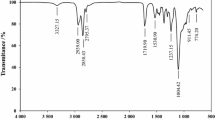Abstract
The thermal behaviour of a new kind of hybrid system based on silanized poly(ether-urethanes) (SPURs) has been analyzed by thermogravimetric analysis (TG). The influence of the chemical nature of employed alkoxysilanes, polyether diol molecular weight and the physical state of the obtained hybrids (cured and non-cured) has been studied. The results show that in the non-cured state, aminosilane-based systems present a higher stability compared with those based on isocyanatesilane. However, in the cured state, both types of hybrids present a similar thermal stability, but much higher than their corresponding partners before the curing process. The presence of the inorganic silica network improves the thermal stability of all the systems studied.















Similar content being viewed by others
References
United States Patent No. 3,971,751. Vulcanizable silylether terminated polymer; 1976.
United States Patent No. 4,444,974. Room temperature curing composition; 1984.
United States Patent No. 4,507,469. Curable composition comprising polyether having silyl group; 1985.
Chef MYL. Curing characteristics and elastic recovery of sealants. Build Environ. 2001;36:925–9.
Ni H, Sailer RA, Skaja AD, Soucek MD. Moisture-curing alkoxysilane functionalized isocyanurate coatings. Macromol Chem Phys. 2000;201(6):722–32.
Rekondo A, Fernández-Berridi MJ, Irusta L. Synthesis of silanized polyether urethane hybrid systems. Study of the curing process through hydrogen bonding interactions. Eur Polym J. 2006;42:2069–80.
Rekondo A, Fernández-Berridi MJ, Irusta L. Photooxidation and stabilization of silanised poly(ether-urethane) hybrid systems. Polym Degrad Stab. 2007;92:2173–80.
Costa L, Camino G, Luda MP, Camaron GG, Quereshi MY. The thermal degradation of poly(propylene oxide) and its complexes with LiBr and LiI. Polym Deg Stab. 1995;48:315–471.
Chuang FS, Tsen WC, Shu YC. The effect of different siloxane chain extenders on the thermal degradation and stability of segmented polyurethanes. Polym Degrad Stab. 2004;84:69–77.
Zhang Y, Xia Z, Huang H, Chen H. Thermal degradation of polyurethane based on IPDI. J Anal Appl Pyrolysis. 2009;84:89–94.
Eklund T, Britcher L, Backman J, Rosenholm JB. Thermogravimetric analysis of γ amino propyl-trimethoxysilane adsorbed on silica support. J Therm Anal Calorim. 1999;58:67–76.
Jiang H, Zheng Z, Song W, Li Z, Wang X. Alkoxysilane functionalized polyurehane/polysiloxane copolymers: synthesis and the effect of end-capping agent. Polym Bull. 2007;59:53–63.
Baudrit JV, Ballestero MS, Vázquez P, Torregosa-Maciá R, Martín Martinez JM. Properties of thermoplastic polyurethane adhesives containing nanosilica with different specific surface and silanol content. Int J Adhes Adhes. 2007;27:469–79.
Yeh JM, Yao CT, Hsieh CF, Yang HC, Wu CP. Preparation and properties of amino terminated anionic waterborne polyurethane silica hybrid materials through a sol–gel process in the absence of an external catalyst. Eur Polym J. 2008;44:2777–83.
Jeon HT, Jang MK, Kim BK, Kim KH. Synthesis and characterization of waterborne polyurethane-nanosilica hybrids using sol–gel process. Colloids Surf A. 2007;302:559–67.
Chen YC, Zhou SX, Yang HH, Wu LM. Interaction and microstructure of polyurethane/silica hybrid films prepared by sol–gel process. J Sol-Gel Sci Technol. 2006;37:39–47.
Chattopadhyay DK, Sreeddhar B, Raju KVJN. Thermal stability of chemically crosslinked moisture-cured polyurethane coatings. J Appl Polym Sci. 2005;95:1509–18.
Acknowledgements
The authors would like to thank the financial support of the Ministerio de Ciencia e Innovación (Interhybrid Project no. MAT 2005-08033-C02-01) and the Fondo Social Europeo (FSE) for the development of this work.
Author information
Authors and Affiliations
Corresponding author
Rights and permissions
About this article
Cite this article
Rekondo, A., Irusta, L. & Fernández-Berridi, M.J. Characterization of silanized poly(ether-urethane) hybrid systems using thermogravimetric analysis (TG). J Therm Anal Calorim 101, 331–337 (2010). https://doi.org/10.1007/s10973-010-0674-3
Received:
Accepted:
Published:
Issue Date:
DOI: https://doi.org/10.1007/s10973-010-0674-3



